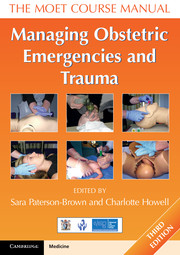Book contents
- Frontmatter
- Dedication
- Contents
- Working Group
- About the authors
- Acknowledgements
- Abbreviations
- Section 1 Introduction
- Section 2 Recognition
- Section 3 Resuscitation
- Section 4 Trauma
- 13 Introduction to trauma
- 14 Domestic abuse
- 15 Thoracic emergencies
- 16 Abdominal trauma in pregnancy
- 17 The unconscious patient
- 18 Spine and spinal cord injuries
- 19 Musculoskeletal trauma
- 20 Burns
- Section 5 Other medical and surgical emergencies
- Section 6 Obstetric emergencies
- Section 7 Triage and transfer
- Section 8 Human issues
- Index
15 - Thoracic emergencies
- Frontmatter
- Dedication
- Contents
- Working Group
- About the authors
- Acknowledgements
- Abbreviations
- Section 1 Introduction
- Section 2 Recognition
- Section 3 Resuscitation
- Section 4 Trauma
- 13 Introduction to trauma
- 14 Domestic abuse
- 15 Thoracic emergencies
- 16 Abdominal trauma in pregnancy
- 17 The unconscious patient
- 18 Spine and spinal cord injuries
- 19 Musculoskeletal trauma
- 20 Burns
- Section 5 Other medical and surgical emergencies
- Section 6 Obstetric emergencies
- Section 7 Triage and transfer
- Section 8 Human issues
- Index
Summary
Objectives
On successfully completing this topic, you will be able to:
identify life-threatening injuries in the chest
identify potentially life-threatening injuries in the chest
be aware of the skills required to manage these life-threatening injuries.
Medical emergencies, including cardiac disease, are discussed in Chapter 22. This chapter focuses on intrathoracic emergencies, mainly caused by trauma but occasionally arising spontaneously, as in the case of spontaneous pneumothorax or aortic aneurysm dissection.
Introduction
In the 2006–08 report of the Confidential Enquiries into Maternal Deaths in the UK, 29 women died from traumatic causes (17 road traffic accidents, 11 murders and one house fire).
Chest injuries are common in patients with major trauma and they are responsible for around one-quarter of trauma deaths. Many of these deaths can be prevented by the prompt recognition of life-threatening conditions and the early initiation of simple methods of treatment. Few patients will require surgery. Most are treated by the simple methods demon strated on the MOET course of needle thoracocentesis and chest drain placement. Prompt and effective resuscitation of the mother, including the avoidance of aortocaval compression is the most effective way of ensuring good fetoplacental perfusion.
Types of injury to the chest
Chest injuries are usually classified as penetrating, blunt or both. When there are external signs of thoracic injury, intra-abdominal organs, including the gravid uterus, may also have been damaged, particularly in the later stages of pregnancy. The reverse is also true, in that obvious abdominal trauma may extend into the chest.
- Type
- Chapter
- Information
- Managing Obstetric Emergencies and TraumaThe MOET Course Manual, pp. 171 - 178Publisher: Cambridge University PressPrint publication year: 2014

